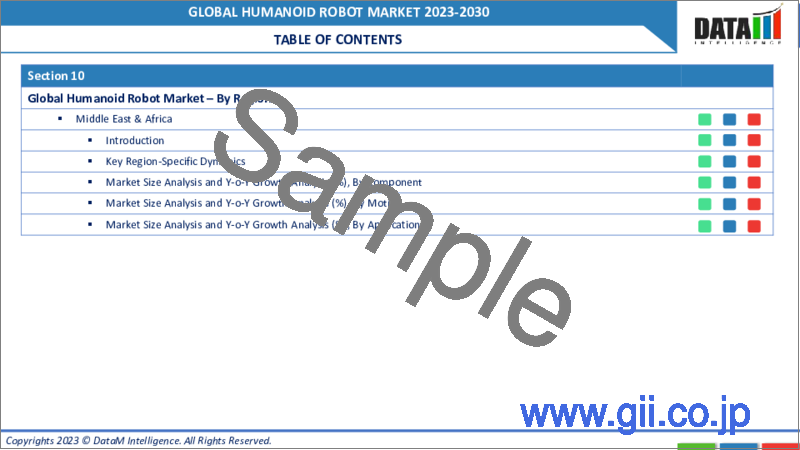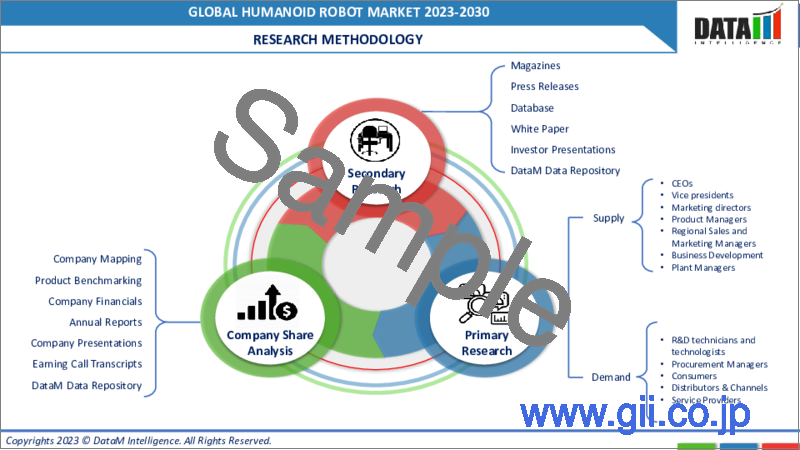|
|
市場調査レポート
商品コード
1255849
ヒューマノイドロボットの世界市場-2023-2030Global Humanoid Robot Market - 2023-2030 |
||||||
|
● お客様のご希望に応じて、既存データの加工や未掲載情報(例:国別セグメント)の追加などの対応が可能です。 詳細はお問い合わせください。 |
|||||||
| ヒューマノイドロボットの世界市場-2023-2030 |
|
出版日: 2023年04月11日
発行: DataM Intelligence
ページ情報: 英文 204 Pages
納期: 約2営業日
|
- 全表示
- 概要
- 目次
市場概要
世界のヒューマノイドロボット市場は、予測期間中(2023-2030年)に28.3%のCAGRで成長する見通しです。
適格なサービスを提供する人型ロボットは、1つの頭部、胴体、2本の腕、2本の脚、顔、目、口など、多くの点で人間に似ています。また、人や他のロボットとコミュニケーションをとり、データを解読し、ユーザーの入力に応じて特定の仕事を行うことができます。また、環境に適応し、目標を追求し続けることができるため、完全な自律型です。人間のようなロボットには、センサーやアクチュエーターが備わっています。多くの場合、ロボットは特定のタスクを実行するようにあらかじめプログラムされています。
市場力学
ヘルスケアでの採用が進む
多くの国では、高齢化や医療需要の増加に伴い、医療従事者が不足しています。ヒューマノイドロボットは、繰り返し行われる仕事を処理し、医療従事者がより困難な仕事に集中できるようにすることで、このギャップを解消することができるのです。また、リハビリテーションの分野でも、ヒューマノイドロボットの活用が進んでいます。
リハビリに使われる人型ロボットは、ReWalk Robotics社が開発した「ReWalk外骨格」です。脊髄を損傷した患者さんがこのロボットを装着し、歩行能力の回復をサポートします。ヘルスケアサービスのニーズが高まり続ける中、ヘルスケア産業におけるヒューマノイドロボットの利用は増加すると予想されます。
高い初期費用と研究開発費
ヒューマノイドロボットの能力を高めるためには、人工知能や機械学習などの新しい技術を生み出すために、企業はコストをかけなければなりません。そのためには、専門家と協力し、高価な機器に投資し、長時間のテストを実施することが必要です。
業界標準の欠如も、ヒューマノイドロボットの開発価格を押し上げる要因のひとつです。各企業が独自の技術を持っている可能性があるため、企業が協力し、専門知識を交換することは難しいかもしれません。努力の重複と研究開発コストの上昇を招く可能性があります。
COVID-19の影響度分析
COVID-19分析では、COVID前シナリオ、COVIDシナリオ、COVID後シナリオに加え、価格力学(パンデミック時やCOVID前シナリオとの比較による価格変動を含む)、需要-供給スペクトラム(取引制限、封鎖、その後の問題による需要と供給のシフト)、政府の取り組み(政府機関による市場、セクター、産業の活性化に関する取り組み)、メーカーの戦略的取り組み(COVID問題を軽減するためのメーカーの取り組み)についても解説しています。
目次
第1章 調査手法とスコープ
- 調査手法
- 調査目的および調査範囲について
第2章 定義と概要
第3章 エグゼクティブサマリー
- コンポーネント別市場内訳
- モーション別市場内訳
- アプリケーション別市場内訳
- 地域別市場内訳
第4章 力学
- 影響要因
- 促進要因
- 成長する製品発表会
- ヘルスケアでの採用が進む
- 抑制要因
- 高いイニシャルコストと研究開発費
- 機会
- 影響度分析
- 促進要因
第5章 産業分析
- ポーターのファイブフォース分析
- サプライチェーン分析
- 価格アナリシス
- レギュラトリー・アナリシス
第6章 COVID-19の分析
- COVID-19の解析について
- COVID-19シナリオ前
- 現在のCOVID-19シナリオ
- ポストCOVID-19またはフューチャーシナリオ
- COVID-19における価格ダイナミクス
- 需給スペクトル
- パンデミック時の市場に関連する政府の取り組み
- メーカーの戦略的な取り組み
- 結論
第7章 コンポーネント別
- ハードウェア
- ソフトウェア
第8章 動議別
- 二足歩行
- ホイールドライブ
第9章 アプリケーション別
- 教育・エンタテインメント
- 調査・宇宙開発分野
- パーソナルアシスタント&ケアギビング
- サーチ&レスキュー
- パブリック・リレーションズ
- その他
第10章 地域別
- 北米
- 米国
- カナダ
- メキシコ
- 欧州
- ドイツ
- 英国
- フランス
- イタリア
- その他欧州
- 南米
- ブラジル
- アルゼンチン
- その他南米地域
- アジア太平洋地域
- 中国
- インド
- 日本
- オーストラリア
- その他アジア太平洋地域
- 中東・アフリカ地域
第11章 競合情勢について
- 競合シナリオ
- 市況分析・シェア分析
- M&A分析
第12章 企業プロファイル
- SoftBank Robotics Group Corp
- 会社概要
- 製品ポートフォリオと説明
- 主なハイライト
- 財務概要
- Kawada Robotics Corporation
- Honda Motor Co., Ltd.
- Hanson Robotics Ltd.
- HYULIM Robot
- PAL Robotics
- Engineered Arts Limited
- Sanbot Co
- Trossen Robotics
- Hajime Research Institute, Ltd
第13章 付録
Market Overview
The global humanoid robot market reached US$ XX million in 2022 and is projected to witness lucrative growth by reaching up to US$ XX million by 2030. The market is growing at a CAGR of 28.3% during the forecast period (2023-2030).
A qualified service, a humanoid robot resembles humans in many ways, including its one head, torso, two arms, two legs, face, eyes and mouth. It can also communicate with people and other robots, decipher data and perform particular jobs in response to user input. It is totally autonomous since it can adapt to its environment and keep pursuing its goals. Human-like robots feature sensors and actuators. Often, the robots are pre-programmed to do specific tasks.
Market Dynamics
Increasing adoption in healthcare
In many nations, there is a scarcity of healthcare personnel as a result of the ageing population and rising demand for healthcare services. By handling repetitive jobs and freeing up healthcare personnel to concentrate on more difficult ones, humanoid robots can help close this gap. Rehabilitation techniques are also being used with humanoid robots.
A humanoid robot used for rehabilitation is the ReWalk exoskeleton created by ReWalk Robotics. Patients with spinal cord damage wear the robot to assist them regain their ability to walk. As the need for healthcare services continues to rise, humanoid robot usage in the healthcare industry is anticipated to rise.
High initial costs and R&D expenses
To increase the capabilities of humanoid robots, businesses must spend in creating new technologies like artificial intelligence and machine learning. It can entail working with expert personnel, investing in pricey equipment and carrying out protracted testing.
Lack of industry standards is another thing that could drive up the price of creating humanoid robots. Because each company could have its own proprietary technology, it may be challenging for businesses to cooperate and exchange expertise. Duplication of effort and higher R&D costs could result.
COVID-19 Impact Analysis
The COVID-19 Analysis includes Pre-COVID Scenario, COVID Scenario and Post-COVID Scenario along with Pricing Dynamics (Including pricing change during and post-pandemic comparing it with pre-COVID scenarios), Demand-Supply Spectrum (Shift in demand and supply owing to trading restrictions, lockdown and subsequent issues), Government Initiatives (Initiatives to revive market, sector or Industry by Government Bodies) and Manufacturers Strategic Initiatives (What manufacturers did to mitigate the COVID issues will be covered here).
Segment Analysis
The global humanoid robot market is segmented based on component, motion, application and region.
The abitlity to fucntion in hazardous conditions for research & space exploration
Research and space exploration are predicted to be the most common applications over the projection period. Since they can function in dangerous or hostile environments, humanoid robots are crucial tools for scientific study and space travel. It is employed for a variety of scientific endeavours, from studying marine life to penetrating the reaches of space. One of the key benefits of using humanoid robots in research is their capacity to operate in environments that are too dangerous or unfriendly for people.
In addition, humanoid robots are used for a variety of space exploration duties, such as monitoring planet surfaces and maintaining satellite orbits. the ability of humanoid robots to operate in hostile or dangerous environments.
Geographical Analysis
Key innovators present in Asia-Pacific
Asia-Pacific is projected to account for a sizeable portion of the market for humanoid robots given that they are the primary inventors and manufacturers of the technology. During the projected era, humanoids will most likely be used in all significant applications in Asia-Pacific. Humanoids will probably be used for personal support and nursing in Asia-Pacific countries like China and Japan, where the elderly population is rising. One of the largest makers of humanoid robots is the countries.
The usage of humanoid robots (HM) for a variety of purposes, including advertising, instructional support and other uses, may lead to a significant increase in the market for these machines in this region. In addition, the COVID-19 pandemic has led to a desire for the employment of humanoids in healthcare and education in countries like China and Japan, which has raised the demand for humanoids in the region.
Competitive Landscape
The major global players in the market are: SoftBank Robotics Group Corp, Kawada Robotics Corporation, Honda Motor Co., Ltd., Hanson Robotics Ltd., HYULIM Robot, PAL Robotics, Engineered Arts Limited, Sanbot Co, Trossen Robotics and Hajime Research Institute, Ltd.
Why Purchase the Report?
- To visualize the global humanoid robot market segmentation based on component, motion, application and region, as well as understand key commercial assets and players.
- Identify commercial opportunities by analyzing trends and co-development.
- Excel data sheet with numerous data points of humanoid robot market-level with all segments.
- PDF report consists of a comprehensive analysis after exhaustive qualitative interviews and an in-depth study.
- Product mapping available as excel consisting of key products of all the major players.
The global humanoid robot market report would provide approximately 61 tables, 58 figures and 204 pages.
Target Audience 2023
- Manufacturers/ Buyers
- Industry Investors/Investment Bankers
- Research Professionals
- Emerging Companies
Table of Contents
1. Methodology and Scope
- 1.1. Research Methodology
- 1.2. Research Objective and Scope of the Report
2. Definition and Overview
3. Executive Summary
- 3.1. Market Snippet By Component
- 3.2. Market Snippet By Motion
- 3.3. Market Snippet By Application
- 3.4. Market Snippet By Region
4. Dynamics
- 4.1. Impacting Factors
- 4.1.1. Drivers
- 4.1.1.1. The growing product launch
- 4.1.1.2. Increasing adoption in healthcare
- 4.1.2. Restraints
- 4.1.2.1. High initial costs and R&D expenses
- 4.1.2.2. XX
- 4.1.3. Opportunity
- 4.1.3.1. XX
- 4.1.4. Impact Analysis
- 4.1.1. Drivers
5. Industry Analysis
- 5.1. Porter's Five Forces Analysis
- 5.2. Supply Chain Analysis
- 5.3. Pricing Analysis
- 5.4. Regulatory Analysis
6. COVID-19 Analysis
- 6.1. Analysis of COVID-19
- 6.1.1. Before COVID-19 Scenario
- 6.1.2. Present COVID-19 Scenario
- 6.1.3. Post COVID-19 or Future Scenario
- 6.2. Pricing Dynamics Amid COVID-19
- 6.3. Demand-Supply Spectrum
- 6.4. Government Initiatives Related to the Market During Pandemic
- 6.5. Manufacturers Strategic Initiatives
- 6.6. Conclusion
7. By Component
- 7.1. Introduction
- 7.1.1. Market Size Analysis and Y-o-Y Growth Analysis (%), By Component
- 7.1.2. Market Attractiveness Index, By Component
- 7.2. Hardware*
- 7.2.1. Introduction
- 7.2.2. Market Size Analysis and Y-o-Y Growth Analysis (%)
- 7.3. Software
8. By Motion
- 8.1. Introduction
- 8.1.1. Market Size Analysis and Y-o-Y Growth Analysis (%), By Motion
- 8.1.2. Market Attractiveness Index, By Motion
- 8.2. Biped*
- 8.2.1. Introduction
- 8.2.2. Market Size Analysis and Y-o-Y Growth Analysis (%)
- 8.3. Wheel Drive
9. By Application
- 9.1. Introduction
- 9.1.1. Market Size Analysis and Y-o-Y Growth Analysis (%), By Application
- 9.1.2. Market Attractiveness Index, By Application
- 9.2. Education & Entertainment*
- 9.2.1. Introduction
- 9.2.2. Market Size Analysis and Y-o-Y Growth Analysis (%)
- 9.3. Research & Space Exploration
- 9.4. Personal Assistant & Caregiving
- 9.5. Search & Rescue
- 9.6. Public Relations
- 9.7. Others
10. By Region
- 10.1. Introduction
- 10.2. Market Size Analysis and Y-o-Y Growth Analysis (%), By Region
- 10.3. Market Attractiveness Index, By Region
- 10.4. North America
- 10.4.1. Introduction
- 10.4.2. Key Region-Specific Dynamics
- 10.4.3. Market Size Analysis and Y-o-Y Growth Analysis (%), By Component
- 10.4.4. Market Size Analysis and Y-o-Y Growth Analysis (%), By Motion
- 10.4.5. Market Size Analysis and Y-o-Y Growth Analysis (%), By Application
- 10.4.6. Market Size Analysis and Y-o-Y Growth Analysis (%), By Country
- 10.4.6.1. U.S.
- 10.4.6.2. Canada
- 10.4.6.3. Mexico
- 10.5. Europe
- 10.5.1. Introduction
- 10.5.2. Key Region-Specific Dynamics
- 10.5.3. Market Size Analysis and Y-o-Y Growth Analysis (%), By Component
- 10.5.4. Market Size Analysis and Y-o-Y Growth Analysis (%), By Motion
- 10.5.5. Market Size Analysis and Y-o-Y Growth Analysis (%), By Application
- 10.5.6. Market Size Analysis and Y-o-Y Growth Analysis (%), By Country
- 10.5.6.1. Germany
- 10.5.6.2. UK
- 10.5.6.3. France
- 10.5.6.4. Italy
- 10.5.6.5. Rest of Europe
- 10.6. South America
- 10.6.1. Introduction
- 10.6.2. Key Region-Specific Dynamics
- 10.6.3. Market Size Analysis and Y-o-Y Growth Analysis (%), By Component
- 10.6.4. Market Size Analysis and Y-o-Y Growth Analysis (%), By Motion
- 10.6.5. Market Size Analysis and Y-o-Y Growth Analysis (%), By Application
- 10.6.6. Market Size Analysis and Y-o-Y Growth Analysis (%), By Country
- 10.6.6.1. Brazil
- 10.6.6.2. Argentina
- 10.6.6.3. Rest of South America
- 10.7. Asia-Pacific
- 10.7.1. Introduction
- 10.7.2. Key Region-Specific Dynamics
- 10.7.3. Market Size Analysis and Y-o-Y Growth Analysis (%), By Component
- 10.7.4. Market Size Analysis and Y-o-Y Growth Analysis (%), By Motion
- 10.7.5. Market Size Analysis and Y-o-Y Growth Analysis (%), By Application
- 10.7.6. Market Size Analysis and Y-o-Y Growth Analysis (%), By Country
- 10.7.6.1. China
- 10.7.6.2. India
- 10.7.6.3. Japan
- 10.7.6.4. Australia
- 10.7.6.5. Rest of Asia-Pacific
- 10.8. Middle East and Africa
- 10.8.1. Introduction
- 10.8.2. Key Region-Specific Dynamics
- 10.8.3. Market Size Analysis and Y-o-Y Growth Analysis (%), By Component
- 10.8.4. Market Size Analysis and Y-o-Y Growth Analysis (%), By Motion
- 10.8.5. Market Size Analysis and Y-o-Y Growth Analysis (%), By Application
11. Competitive Landscape
- 11.1. Competitive Scenario
- 11.2. Market Positioning/Share Analysis
- 11.3. Mergers and Acquisitions Analysis
12. Company Profiles
- 12.1. SoftBank Robotics Group Corp
- 12.1.1. Company Overview
- 12.1.2. Product Portfolio and Description
- 12.1.3. Key Highlights
- 12.1.4. Financial Overview
- 12.2. Kawada Robotics Corporation
- 12.3. Honda Motor Co., Ltd.
- 12.4. Hanson Robotics Ltd.
- 12.5. HYULIM Robot
- 12.6. PAL Robotics
- 12.7. Engineered Arts Limited
- 12.8. Sanbot Co
- 12.9. Trossen Robotics
- 12.10. Hajime Research Institute, Ltd
LIST NOT EXHAUSTIVE
13. Appendix
- 13.1. About Us and Services
- 13.2. Contact Us




